Key Documents
T1426
Trypsin from bovine pancreas
TPCK Treated, essentially salt-free, lyophilized powder, ≥10,000 BAEE units/mg protein
Synonim(y):
Serine Protease 1
About This Item
Polecane produkty
pochodzenie biologiczne
bovine pancreas
Poziom jakości
klasa czystości
Proteomics Grade
Postać
essentially salt-free, lyophilized powder
aktywność właściwa
≥10,000 BAEE units/mg protein
masa cząsteczkowa
23.8 kDa
rozpuszczalność
hydrochloric acid: soluble 1 mM
Zastosowanie
diagnostic assay manufacturing
obecność zanieczyszczeń
Chymotrypsin ≤0.1 BTEE units/mg protein
temp. przechowywania
−20°C
Szukasz podobnych produktów? Odwiedź Przewodnik dotyczący porównywania produktów
Zastosowanie
Działania biochem./fizjol.
Serine protease inhibitors, including DFP, TLCK, APMSF, AEBSEF, and aprotinin, amongst others, will inhibit Trypsin.
Komponenty
Przestroga
Definicja jednostki
Uwaga dotycząca przygotowania
It is also TPCK-treated and dialyzed. Treatment with L-1-Tosylamide-2-phenylethyl chloromethyl ketone (TPCK) reduces the chymotrypsin activity which is usually present in trypsin.
inhibitor
substrat
Hasło ostrzegawcze
Danger
Zwroty wskazujące rodzaj zagrożenia
Zwroty wskazujące środki ostrożności
Klasyfikacja zagrożeń
Eye Irrit. 2 - Resp. Sens. 1 - Skin Irrit. 2 - STOT SE 3
Organy docelowe
Respiratory system
Kod klasy składowania
11 - Combustible Solids
Klasa zagrożenia wodnego (WGK)
WGK 1
Środki ochrony indywidualnej
dust mask type N95 (US), Eyeshields, Faceshields, Gloves
Certyfikaty analizy (CoA)
Poszukaj Certyfikaty analizy (CoA), wpisując numer partii/serii produktów. Numery serii i partii można znaleźć na etykiecie produktu po słowach „seria” lub „partia”.
Masz już ten produkt?
Dokumenty związane z niedawno zakupionymi produktami zostały zamieszczone w Bibliotece dokumentów.
Klienci oglądali również te produkty
Protokoły
This procedure is for products with a specification for Trypsin activity using Na-Benzoyl-L-arginine ethyl ester (BAEE) as a substrate. The procedure is a continuous spectrophotometric rate determination (A253, Light path = 1 cm).
Ciągła spektrofotometryczna metoda oznaczania szybkości przy użyciu substratu BAEE mierzy aktywność trypsyny, niezbędną do charakterystyki enzymu.
Nasz zespół naukowców ma doświadczenie we wszystkich obszarach badań, w tym w naukach przyrodniczych, materiałoznawstwie, syntezie chemicznej, chromatografii, analityce i wielu innych dziedzinach.
Skontaktuj się z zespołem ds. pomocy technicznej










